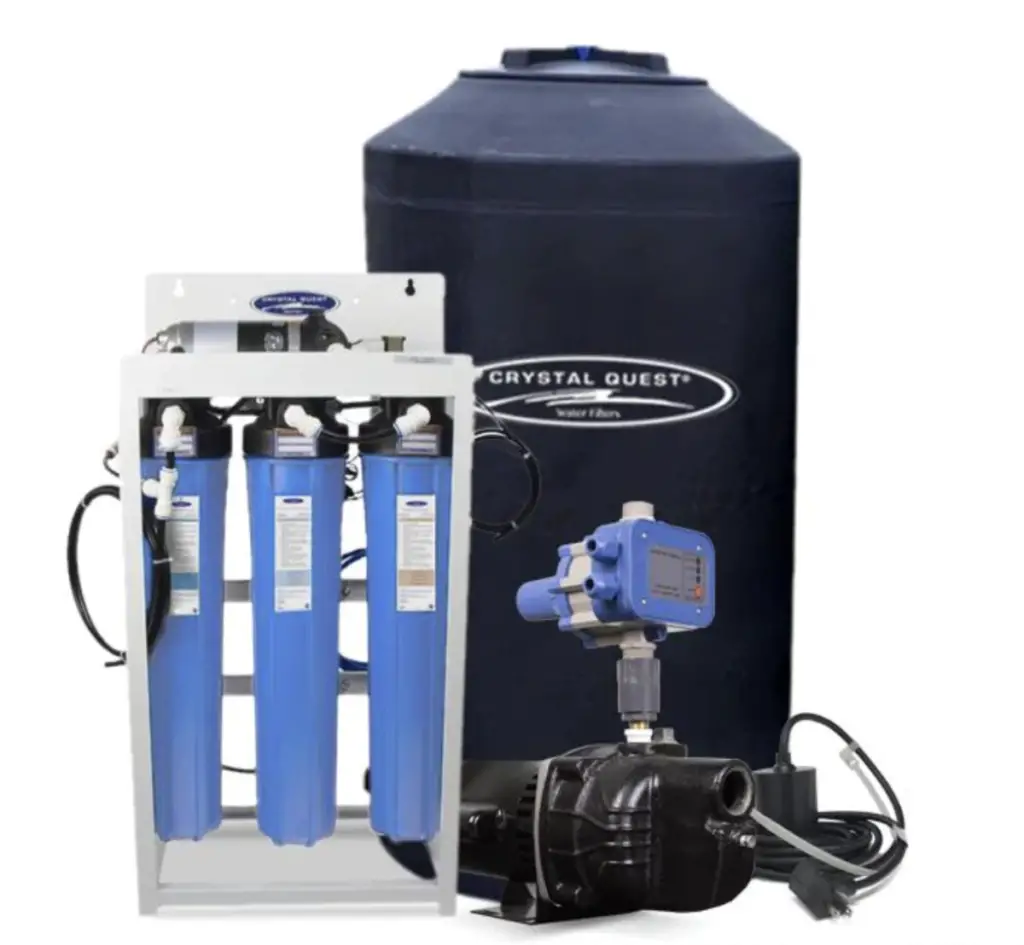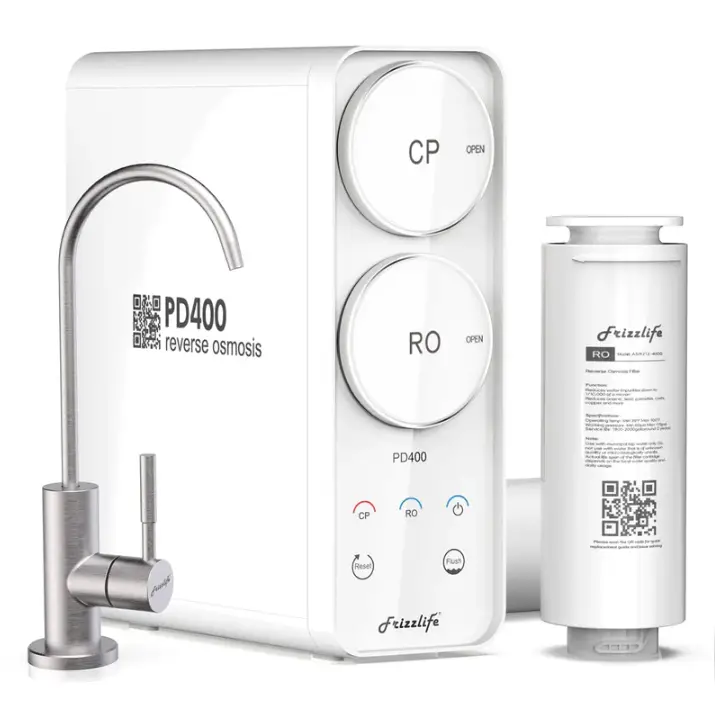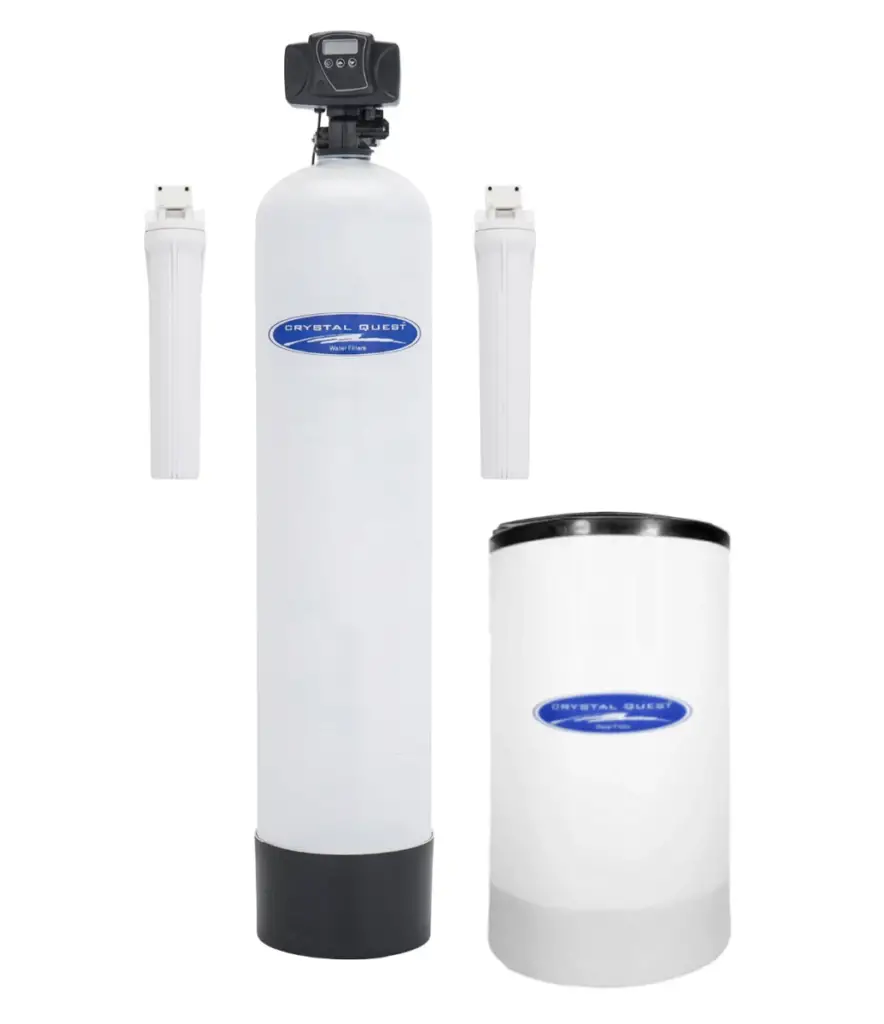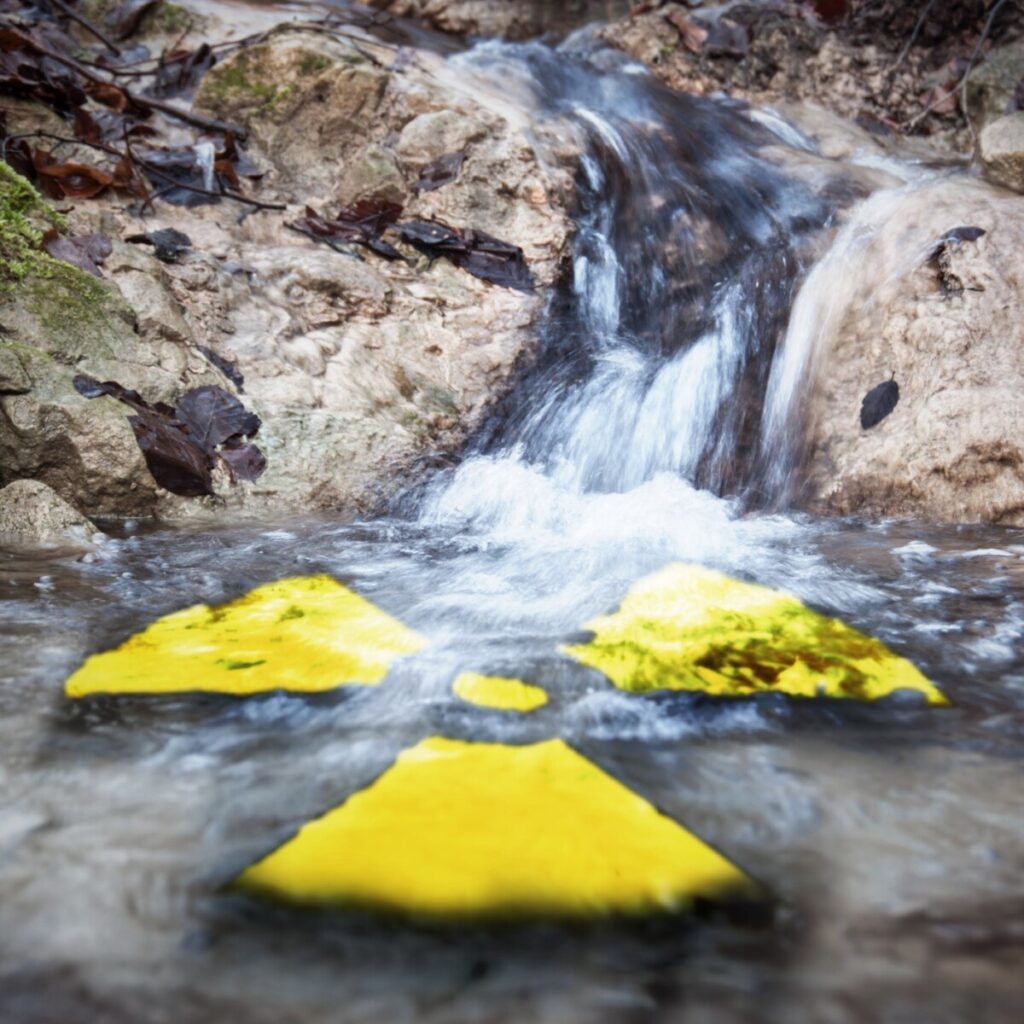Every creature on Earth, including human beings, is exposed to radium and other forms of natural radiation. It is present in the air we breathe, the food we consume and even the water we drink, but radium should be removed from water if it exceeds 5 picocurie per liter.
Radium can be removed by ion exchange softeners, reverse osmosis and distillation systems. Reverse osmosis is the most effective and can remove up to 99% of the radium in water, whereas ion exchange and lime softening can remove up to 90%.
In this article, we will examine the properties of radium and its possible effects on the human body, especially when ingested via drinking water. We will also recommend the best filtration system to remove this metal and where you can buy a radiation water testing kit.
What is radium and how does it get into your water supply?
Radium is the heaviest alkaline metal found on the Earth’s crust. It is rarely seen in its pure silvery-white metallic form, but many varieties of radium (called isotopes) exist in minimal proportions (one part per trillion) in every kind of soil, mineral and other geologic materials, as well as plants and foods.
The radium in soil transforms into radon, which is then released into the air.
Radon is believed to play a crucial role in the evolution of life on our planet, as it helps regulate the meteorological conditions in the atmosphere.
At the same time, radon in our homes is the main source of exposure to ionizing radiation and it is the second leading cause of lung cancer (due to poor ventilation).
The forms of naturally occurring radium found in groundwater are known as radium 224, 226, and 228.
Can water filters remove radium?
There are various methods to remove radium from water. Ion exchange, lime softening and reverse osmosis systems have been identified by the US EPA as some of the “best available technology” (BAT) and can remove up to 90 percent of radium in drinking water.
However, if you source your drinking water from a public supply, there is often no reason to worry about installing a filtration system, especially to remove radium. You can keep up to date with your municipality’s reports for local contaminants to ensure that the quality of your water remains within the safety standards.
In the case of private water supplies, well owners are encouraged to conduct regular testing for radium and other dangerous contaminants (such as viruses and bacteria that are likely to develop in private wells).
If hazardous levels of radium are discovered, private well owners should purchase bottled water for drinking and cooking, drill a new well to a depth with lower radium levels, or install a whole-home water treatment unit that can remove radium.
Choosing the right treatment system depends on many factors including what other contaminants are present in your water, your water usage, the installation costs, and the maintenance costs. You should consult an expert to help you decide what treatment system is best for your situation.
Ion exchange
Water softeners that use cation ion exchange technology can remove 90 percent of radium.
This method normally removes the calcium and magnesium ions found in hard water. However, radium has a similar chemical structure to calcium and is also removed (along with the calcium) by exchanging radium ions with sodium (or sometimes potassium) ions.
Although, people on low sodium diets need to be mindful of this method, and be aware that the sodium content of their water will be elevated.
Lime softening
The lime softening process uses hydrated lime or quicklime to raise the pH in water (make it more alkaline) and thus remove calcium and magnesium deposits by chemical precipitation.
As radium is chemically and physically similar to calcium, conventional single stage lime softening can remove between 50 and 80 percent of radium.
Enhanced lime softening, where the pH is further increased in a second stage, can remove up to 90 percent of radium and uranium and may also remove arsenic, iron, and manganese.
Reverse osmosis
Reverse osmosis systems use the natural process of osmosis to reverse the flow of water, pushing it through a semipermeable membrane that filters common chemical contaminants including sodium, chloride, copper, chromium, and lead.
This purification system can also effectively reduce radium levels up to 99%.
While no federal regulations exist for residential water treatment filters, purifiers and reverse osmosis systems, voluntary national standards and NSF protocols have been developed that establish minimum requirements for the safety and performance of these products to treat drinking water.
According to the NSF standards, refrigerator filters and distillation systems are not certified for radium reduction. Only the NSF/ANSI 44 and NSF/ANSI 58 filters are certified to reduce radium 226 and 228, which correspond to cation exchange water softeners and reverse osmosis treatment systems respectively.
It is important to note that testing against NSF standards are not compulsory, but optional for a brand. However, it is ideal if the filter is NSF certified, or tested by an independent lab against the NSF/ANSI criteria, as this confirms the reduction claims of a given company.
Best filters to remove radium from drinking water
Lime softeners are generally used in water treatment plants and not available in our homes. The residential methods available to remove radium from drinking water are cation exchange water softeners and reverse osmosis systems.
Here are the best units for each product category:
Best reverse osmosis systems to remove radium
Crystal Quest Whole house reverse osmosis system

This whole house RO system is backed by 25 years of experience of Crystal Quest. Thanks to its efficient filters, it removes radium as well as heavy metals, nitrates and fluoride.
This system is a commercial-grade RO System with options from 200 to 7,000 GPD available. It comes with a water storage tank so that you will always have radium-free, purified water available for drinking.
Crystal Quest also has some great under sink and countertop RO systems available if you prefer a point-of-use system (rather than a whole house solution.
Frizzlife Reverse Osmosis System

The Frizzlife PD400 RO system with tankless design has a pre-filter and RO membrane that eliminate thousands of harmful contaminants including lead, chlorine, fluoride, TDS, heavy metals and radium.
It has a low drain ratio to significantly reduce the waste water that these systems often release. Another interesting feature is that it can be connected to refrigerators.
Best cation exchange water softeners to remove radium
Crystal Quest Whole House Water Softener with Pre/Post Filtration (3 Stages of Filtration)

Crystal Quest’s water softener has three stages of filtration: one 20-inch sediment cartridge that removes sediment, silt, sand and dirt; an ion exchange mineral tank and brine water conditioner where radium, calcium and magnesium are removed.
This softener also has a 20 inch solid carbon cartridge to remove volatile organic compounds (VOCs), and chemicals such as insecticides, pesticides and industrial solvents that may be leached into the water supply.
DURAWATER Fleck 5600 SXT Iron Blaster 48,000 Grain Water Softener
This water softener by Durawater is very easy to install. Through the iron exchange process, it effectively removes iron (up to 6-8 ppm range), manganese (up to 6 ppm), calcium, sediment, sand, rust and radium.
It has a digital meter with customizable settings to monitor the water quality and the condition of your unit.
Related Questions
How radioactive is radium?
The peculiarity of radium is that it is the only element among all alkaline metals that emits natural radiation when it disintegrates. Although it is not the only nor the most radioactive element available (that’s polonium).
This energy is continuously released into the environment during decay until a new, nonradioactive substance is formed. Scientists measure the characteristics of this energy, which appears in the form of particles or waves, to identify the specific radioactive element. There are three types of radiation:
- Alpha particles: they travel short distances and cannot penetrate the human skin.
- Beta particles: they can penetrate skin but cannot travel around the body.
- Gamma particles or waves: they enter the body and are carried to all the body parts.
Gamma particles are the most dangerous ones, as they can destroy cells.
For that reason, people must be shielded when in their presence to avoid exposure. However, when these selective killers are directed against tissues such as cancer cells that are harmful to human beings, they become a life-saving medical tool.
Not all radium isotopes produce gamma emissions.
In fact, the ones generally found in water are associated with alpha particles.
Surface water and shallow wells both have certain levels of radium, especially in cases with low pH levels (acidic water) as radium readily dissolves in acidic conditions.
Other natural and anthropogenic factors influence the levels of radium found in drinking water supplies.
For example, some deep bedrock aquifers contain higher concentrations of radium that sometimes exceed the regulatory standards established by the US EPA.
The EPA has established a maximum permissible level of 5 picocurie per liter for combined radium 226 and 228, and 15 picocurie per liter for gross alpha radiation in drinking water.
Picocurie is the unit used to measure the quantity of radioactive material in the United States. One picocurie equals one-trillionth of a curie and is written pCi.
How does radium enter your home?
Private drilled wells, as well as thermal or mineral waters, are more likely to contain concerning levels of radium than public utilities. Other water systems prone to having higher amounts of this unstable element are those in areas where there are mining activities for uranium or other minerals such as granites and phosphates.
The use of certain fertilizers, as well as fossil fuels, have also impacted the distribution of radium in the environment.
Radium builds up inside plants and animals, especially in fish, and is transferred along the food chain to eventually reach humans.
The average amount of radium in food is 0.01 to 0.03 picocurie per gram. While the contribution of drinking water to the total radium intake is generally lower (75%) than that of dietary ingestion, especially when sourced from surface water.
Ingestion is the most common route of entry, and the radiation emitted inside the body after digestion may damage tissues, depositing on teeth and bones. Fortunately, 80% of the radium ingested is released through feces.
What are the health impacts of radium?
The major health hazard is actually the inhalation of radium in the form of radon, which goes into the lungs and deposits on the mucous lining along the respiratory tract. In the long term, this may lead to cancer.
The exposure to radium for extended periods may cause the depression of the immune system, anemia, fractured teeth and cataracts. Chronic exposure to higher levels increases the chances of developing bone, liver or breast cancer, although this is generally linked to high levels of radium ingested through occupational activities.
In fact, the EPA estimates that the lifetime risks associated with drinking water containing 5pCi/L of radium is about one in 10,000.
This risk increases as the concentration of radium rises. The risk associated with consuming water containing 5 pCi/l of radium for one year is comparable to one chest X-ray, or the cosmic radiation received during five or fewer round trip flights from Maryland to California.
On the other hand, it is believed that bathing and showering in water containing radium does not present a health concern.
Since radium has no smell or taste, the only way to identify its presence is testing the water.
How do you test for radium in water?
Many municipalities recommend testing for uranium instead of radium. A uranium test is generally less expensive than a radium test, and these two minerals often occur together. A gross-alpha test is the most appropriate when first determining if you have a radiation (and radium) problem in your water.
All public water supplies are regularly tested and monitored against the US EPA standards. Private well owners are responsible for the safety of their drinking water and must conduct regular testing for all kinds of contaminants, including radium.
There is also a likelihood of higher concentration of radium found in water with higher concentrations of total dissolved solids.
The World Health Organization recommends doing an initial screening for gross (meaning ‘total’) alpha activity and gross beta activity to determine the presence of specific radioactive substances, such as radium 224, radium 226 and uranium.
In some cases, less expensive tests like pH and conductivity can be used to estimate if the gross alpha or radium levels are likely to exceed drinking water standards. The Maryland Department of the Environment offers the following measuring guidelines:
- If short-term gross alpha levels are less than 5 pCi/l, then no additional radiation tests are needed because the water meets safety requirements.
- If short-term gross alpha levels exceed 5 pCi/l but are less than 15 pCi/L, then combined radium tests may be needed.
- If the short-term gross alpha activity exceeds 15 pCi/l, then no additional radium tests are needed. This result in itself indicates an exceedance of the maximum contaminant level.
To arrange for a short-term gross alpha test, a private well owner should contact their local health department or an accredited radiological water testing laboratory.
MyTapScore have a Full Radiation Water testing kit for $119.00. It is particularly ideal for anyone using a domestic well as their water supply (but can be used on any type of drinking water). The test includes gross-alpha and beta testing.
- Order today and they’ll send out the kit and instructions on how to collect the samples.
- Shipping is included.
- Samples are tested in a certified laboratory.
- You’ll get the results in about 12 days.
For more information and to order your Full Radiation Water testing kit click here.
Does tap water have radium?
All tap water contains traceable amounts of radium, particularly the isotopes radium 224, 226, and 228. These forms of radium emit alpha and beta particles during decay. Any exposure to radiation presents a degree of risk, but there are regulatory standards below which radium has no health effects.
When sourced from a public water system, the levels of radium are generally within the limits established by the US EPA, which are substantially below the hazardous levels. Private wells may hold higher concentrations from the radium dissolved in groundwater.
Since it has no smell or taste, it is crucial to regularly test for radium and other chemical constituents that may have leached into your well. Other elements such as pathogenic microorganisms are more likely to contaminate your drinking water when you have a private well.
Does bottled water have radium?
Most bottled water comes from a groundwater source (a well or a spring). Groundwater is generally less vulnerable to contamination than water from surface sources, but it tends to contain naturally high amounts of certain contaminants, including radioactive elements like radium.
Bottled water is subject to the standards for radiological contaminants set by the US Food and Drug Administration.
The FDA requires bottled water to be tested regularly for the same contaminants as public tap water supplies, including radioactive elements like radium. When EPA sets a new standard for a contaminant in tap water, the FDA must establish a new standard for the same contaminant in bottled water or find that EPA’s new standard is not applicable to bottled water.
The NSF is the only accredited product certification program that offers analysis for bottled water, including microbiological, chemical and radiological analyses in accordance with national and international regulations, such as FDA, EPA, EU, ANVISA, BIS and China Natural Mineral Water.
Does Brita remove radium?
Brita filters with an Ion Exchanger can reduce carbonate hardness (calcium and magnesium ions) from your water, which suggests that it may also act on radium. However, radium does not appear within the contaminants that Brita filters are certified to reduce.
Only reverse osmosis systems and ion exchange water softeners can claim to effectively remove radium from drinking water. Brita filters contain an ion exchange resin, but they do not soften water.
Water Purification Guide has more information on whether Brita filters soften water available here.



